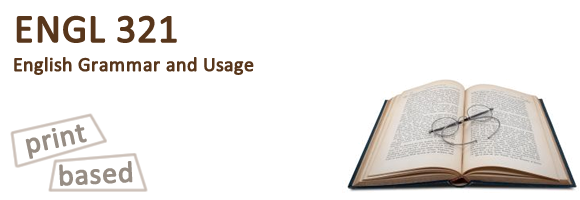
Mode of Delivery
This is a print-based, correspondence course.
Course Outline
- Six assignments
- Final examination
Course Description and Prerequisite
English 321 examines Traditional Grammar from its origins to its codification in modern English grammars. This distance education section presents the principles, methodology and application of traditional grammatical descriptions of English: classification of parts of speech in formal and functional terms, sentence analysis, and usage prescriptions.
Prerequisite: Six credits of first-year English and third-year standing.
Intended Audience
This course is addressed to all students with an interest in the English Language, including those whose primary interest may be in English as a Second Language, English Education, or English Literature. It may also be of interest to students of other languages who wish to learn the methods of Traditional Grammar as a means of common uniform description of more than one language, useful in foreign language teaching. For many people, the course will be an opportunity to get to know what they have always wanted to know—what grammatical terms refer to and what is considered ‘correct’ and why.
No previous background in linguistic description is required. Students will learn traditional grammatical terminology and its application to words and sentences of English, all the necessary terms and methods being taught in the course.
Course Objectives
When you have completed English 321, you will:
- be able to identify and name parts of speech, and to parse sentences;
- be able to identify and name kinds and parts of the sentence, i.e., to perform clause analysis;
- know how the principles, methods, and terminology of Traditional Grammar came to be the way they are;
- understand how notions of correctness relate to the principles and development of Traditional Grammar.
Course Overview
The topics in English 321 are covered in six lessons as follows:
| Lesson 1 | gives an overview of the parts of speech, together with the principles of classification. Next, the categories and sub-categories of major class words are presented. |
| Lesson 2 | continues the examination of parts of speech by first setting out the Minor word classes and explaining their categorization. The lesson continues by reviewing the parts of speech in terms of content and structure words and explaining various kinds of word structure. Last, the lesson examines the functional shift of major parts of speech. |
| Lesson 3 | looks first at the different forms of simple sentence in terms of illocutionary force and then examines the active and passive forms of sentences, and the expression of tense, modality, and aspect within a sentence. Next, it explains the functional analysis of simple sentences which leads to a demonstration of functional analysis in the model of Traditional Grammar. |
| Lesson 4 | examines and explains the structure of complex and compound sentences. |
| Lesson 5 | starts by explaining the notion of ‘Ranks’–Sentence, Clause, Phrase, and Word–and then explains the form and function of various kinds of phrase. Then the sentence functions of the various kinds of phrase are enumerated and explained. Finally, the methodology of phrase analysis is demonstrated and explained. |
| Lesson 6 | first presents the overall system of Traditional Grammar as a model of linguistic description in its classification of structures, functions, grammatical categories, and grammatical processes. Then the lesson looks at the ‘prescriptive’ aspect of Traditional Grammar, and offers definitions of ‘correctness’, ‘usage’, and ‘standardness’ in relation to English. The historical background to the establishment of prescriptive rules is outlined, and the rules themselves are examined and evaluated. |
Course Work
- Self-Testing and Review Exercises
The course manual provides many self-test and review exercises, with their answers provided in an Appendix. These exercises allow you to monitor your progress through each part of the course. - Assignments
There are six graded assignments, one following each lesson, and related to the content of that lesson. Most questions are objective, asking for short, specific answers, and are in the same form as questions in the self-test exercises and text. When a longer, discursive answer is required, the question will clearly indicate so. - Final Examination
The course requirements are completed by writing a final examination which consists of the kind of questions you will have become accustomed to in the assignments, and which covers all the course content.
Evaluation
The course grade for English 321 is computed as follows:
| Six Assignments @10% each | 60% |
| Final Examination | 40% |
| Total | 100% |
Students must pass the final examination in order to pass the course as a whole.
Textbooks
Required Materials:
Greenbaum, Sidney and Randolph Quirk. A Student’s Grammar of the English Language. Addison Wesley Publishers, ISBN: 9780582059719
ENGL 321 Learner Package (includes course manual)
Recommended:
Gucker, Philip. Essential English Grammar. New York: Dover, 1966.
